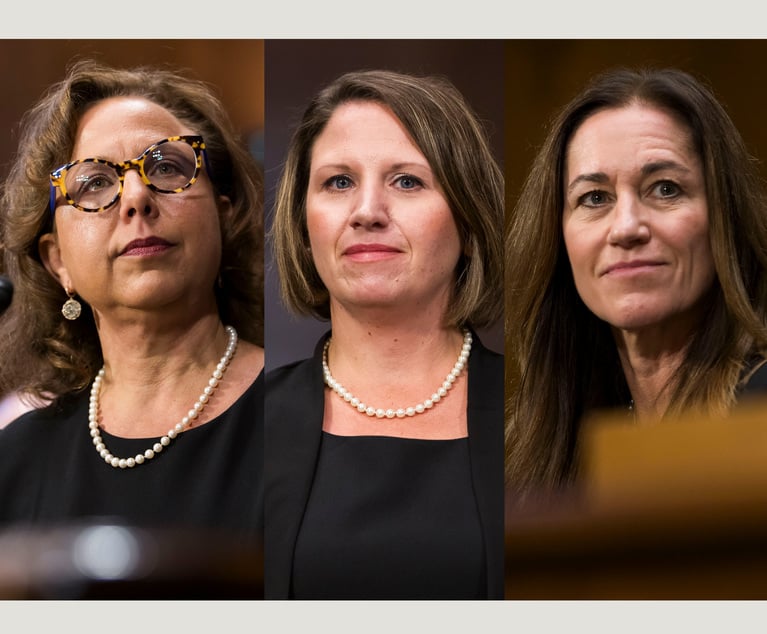Sea Change in Class Action Settlement Process: A Year Under Revised Rule 23(e)
Effective Dec. 1, 2018, the U.S. Supreme Court amended Federal Rule of Civil Procedure 23(e) governing the class action settlement process. The amendments created a sea change in the settlement approval process that is critical to both plaintiffs and defense counsel in class cases.
January 23, 2020 at 01:28 PM
8 minute read
 Ira Neil Richards and Arleigh P. Helfer of Schnader Harrison Segal & Lewis.
Ira Neil Richards and Arleigh P. Helfer of Schnader Harrison Segal & Lewis.
Effective Dec. 1, 2018, the U.S. Supreme Court amended Federal Rule of Civil Procedure 23(e) governing the class action settlement process. The amendments created a sea change in the settlement approval process that is critical to both plaintiffs and defense counsel in class cases.
The amendments frontload the settlement-approval process. Where the threshold for preliminary approval used to be relatively low, the amendments heighten the showing a settlement proponent must make before the court may authorize notice of the proposed settlement to the class.
It is crucial that counsel understand what will be required at the initial phase of the approval process in order to move class settlements through that process successfully. Over the course of the last year, application of revised Rule 23(e) in practice has shed light on how federal courts are reacting to it, giving practitioners guidance to help them navigate the new requirements.
Background
A decision by the parties to settle a class action almost always follows extensive and costly legal proceedings. However, finally signing the settlement agreement in a class action does not end the case, as the settling parties must obtain court approval. A court approving a class settlement must satisfy itself, acting as a fiduciary, that the settlement is fair to the class. Rule 23(e) requires federal courts to scrutinize class settlements to make sure that the terms truly are arm's length and reasonable bargains, as opposed to, for instance, the result of a "reverse auction" where a defendant whipsawed different sets of plaintiffs lawyers in parallel cases.
Over the course of time, the court-approval process has evolved. While it has long involved two separate steps—preliminary approval and then final approval after notice to the class—the December 2018 amendments to Rule 23(e) have significantly altered the process, placing greater emphasis on the first step, when the court must decide whether to allow the parties to send notice of the proposed settlement to the class.
Settlement Approval Practice Before December 2018
If the parties sought preliminary approval of a settlement a few years ago, their burden at that first step was relatively light. Courts generally would grant preliminary approval and direct notice to the class if a proposed settlement appeared on its face to be in the range of possible approval. Typically, the parties submitted relatively little and principally basic information to the court at this stage.
After absent class members had a chance to opt out or object to the settlement, the proponent of the settlement would move for final approval and submit more detailed record materials in support of its motion. Courts would then look to those record materials to assess the fairness, reasonableness and adequacy of the settlement, applying factors the U.S. Court of Appeals for the Third Circuit developed in Girsh v. Jepson, 521 F.2d 153 (3d Cir. 1975), and in In re Prudential Insurance America Sales Practice Litigation, 148 F.3d 283 (3d Cir. 1998), to guide that inquiry.
Over time, courts found this regime unsatisfactory because it did not ensure that parties would provide sufficient information at the preliminary approval stage for courts to assess the settlement terms. Also, courts have become increasingly concerned about ensuring that there is sufficient information in the record and available to absent class members to exercise their rights.
2018 Amendments to Rule 23(e)
Effective December 2018, the U.S. Supreme Court amended Rule 23(e) and changed the settlement-approval process. The amendments reflect a trend in court decisions demanding more from the parties at the earliest stage. Now, before the court may direct notice to absent class members, Rule 23(e)(1)(A) requires the parties to "provide the court with information sufficient to enable it to determine whether to give notice of the proposal to the class." And Rule 23(e)(1)(B) requires the court to allow the parties to give notice to the class only if notice "is justified by the parties' showing that the court will likely be able to: approve the proposal under Rule 23(e)(2); and certify the class for purposes of judgment on the proposal."
In short, the 2018 amendments frontload the settlement approval process. The settling parties must prove, even before notice goes to the class, that the settlement "likely" deserves court approval. The advisory committee commentary explains that the "decision to give notice of a proposed settlement to the class is an important event" and that it "should be based on a solid record supporting the conclusion that the proposed settlement will likely earn final approval after notice and an opportunity to object." Accordingly, the "proponents of the settlement should ordinarily provide the court with all available materials they intend to submit to support final approval under Rule 23(e)(2)" when they seek an order directing notice to the class. That is, settling parties can no longer wait until the final approval stage to make their record proving that their settlement is fair to the class.
Requiring a More Exacting Inquiry Before Directing Notice
For the past year, district courts have taken the new approval regime to heart, often observing that the process now requires a more searching inquiry on a more complete record. For example, one court observed that the new standards require courts to "assess at the preliminary approval stage whether the parties have shown that the court will likely find that the factors weigh in favor of final settlement approval" and that the new standard is "more exacting than the prior requirement," see In re Payment Card Interchange Fee & Merchant Discount Antitrust Litigation, 330 F.R.D. 11, 28 (E.D.N.Y. 2019). Similarly, another court noted that, as a result of the 2018 amendments, "review for preliminary approval is more robust," as in O'Connor v. Uber Technologies, 2019 U.S. Dist. LEXIS 54608 (N.D. Cal. Mar. 29, 2019).
Applying the new standards, courts have rejected proposed settlements at the preliminary approval stage where the parties failed to submit sufficient record materials and arguments. For example, one court declined to order notice because the "Court and class members lack information about certain key components of the settlement," see Chi v. University of Southern California, 2019 U.S. Dist. LEXIS 103436 (C.D. Cal. Apr. 18, 2019). The court identified numerous informational deficiencies, including that the parties did not address the true substantive risks of proceeding to trial, did not estimate what a potential class member might recover in an individual action, and did not provide a "direct assessment of the substantive strength of Plaintiffs' claims and what defenses are available to Defendants."
Thus, the amendments to Rule 23(e) appear to be having the intended effect, with courts becoming more exacting in the threshold showing required before they authorize notice to the class. Parties can expect courts to demand a thorough record-based analysis of the benefits of the settlement.
Frontloading a robust fairness inquiry into the preliminary approval stage will likely cause the parties to incur costs earlier in the settlement process, even before knowing whether a court will approve notice going out to the class. For example, parties asking for court permission to send notice may need to present the court with expert analysis of matters relevant to their proposal and incur those costs as they attempt to satisfy more demanding standards at the preliminary approval stage.
The Takeaways
Under the new class settlement approval process, parties must take pains to meet more stringent requirements. Counsel moving the court to direct notice to the class must be careful to develop and provide the court with a solid record showing that the proposal is likely to obtain final approval when measured against the Rule 23(e)(2) factors. In addition, counsel must show the court that the proposed settlement class meets Rule 23's class certification requirements. This means that the parties should be prepared at the preliminary approval stage to present the court with materials such as expert affidavits to demonstrate the economic benefits of the settlement compared to the potential damages and risks. In multistate class actions under state law, parties should be prepared at this stage to present an analysis of state laws and their relationship to the settlement terms. In short, parties at the preliminary approval stage should be prepared to treat it as a dress rehearsal for final approval.
Ira Neil Richards is a partner at Schnader Harrison Segal & Lewis and chair of the firm's class action practice group. Richards practices nationally representing clients in complex litigation matters. Contact him at [email protected].
Arleigh P. Helfer is an associate at the firm and a member of several practice groups, including class action, appellate, aviation, antitrust, energy and environmental and financial services. He concentrates his practice in commercial litigation. Contact him at [email protected].
This content has been archived. It is available through our partners, LexisNexis® and Bloomberg Law.
To view this content, please continue to their sites.
Not a Lexis Subscriber?
Subscribe Now
Not a Bloomberg Law Subscriber?
Subscribe Now
NOT FOR REPRINT
© 2025 ALM Global, LLC, All Rights Reserved. Request academic re-use from www.copyright.com. All other uses, submit a request to [email protected]. For more information visit Asset & Logo Licensing.
You Might Like
View All
Pa. Federal District Courts Reach Full Complement Following Latest Confirmation

The Defense Bar Is Feeling the Strain: Busy Med Mal Trial Schedules Might Be Phila.'s 'New Normal'
7 minute read
Federal Judge Allows Elderly Woman's Consumer Protection Suit to Proceed Against Citizens Bank
5 minute read
Judge Leaves Statute of Limitations Question in Injury Crash Suit for a Jury
4 minute readTrending Stories
- 1Uber Files RICO Suit Against Plaintiff-Side Firms Alleging Fraudulent Injury Claims
- 2The Law Firm Disrupted: Scrutinizing the Elephant More Than the Mouse
- 3Inherent Diminished Value Damages Unavailable to 3rd-Party Claimants, Court Says
- 4Pa. Defense Firm Sued by Client Over Ex-Eagles Player's $43.5M Med Mal Win
- 5Losses Mount at Morris Manning, but Departing Ex-Chair Stays Bullish About His Old Firm's Future
Who Got The Work
J. Brugh Lower of Gibbons has entered an appearance for industrial equipment supplier Devco Corporation in a pending trademark infringement lawsuit. The suit, accusing the defendant of selling knock-off Graco products, was filed Dec. 18 in New Jersey District Court by Rivkin Radler on behalf of Graco Inc. and Graco Minnesota. The case, assigned to U.S. District Judge Zahid N. Quraishi, is 3:24-cv-11294, Graco Inc. et al v. Devco Corporation.
Who Got The Work
Rebecca Maller-Stein and Kent A. Yalowitz of Arnold & Porter Kaye Scholer have entered their appearances for Hanaco Venture Capital and its executives, Lior Prosor and David Frankel, in a pending securities lawsuit. The action, filed on Dec. 24 in New York Southern District Court by Zell, Aron & Co. on behalf of Goldeneye Advisors, accuses the defendants of negligently and fraudulently managing the plaintiff's $1 million investment. The case, assigned to U.S. District Judge Vernon S. Broderick, is 1:24-cv-09918, Goldeneye Advisors, LLC v. Hanaco Venture Capital, Ltd. et al.
Who Got The Work
Attorneys from A&O Shearman has stepped in as defense counsel for Toronto-Dominion Bank and other defendants in a pending securities class action. The suit, filed Dec. 11 in New York Southern District Court by Bleichmar Fonti & Auld, accuses the defendants of concealing the bank's 'pervasive' deficiencies in regards to its compliance with the Bank Secrecy Act and the quality of its anti-money laundering controls. The case, assigned to U.S. District Judge Arun Subramanian, is 1:24-cv-09445, Gonzalez v. The Toronto-Dominion Bank et al.
Who Got The Work
Crown Castle International, a Pennsylvania company providing shared communications infrastructure, has turned to Luke D. Wolf of Gordon Rees Scully Mansukhani to fend off a pending breach-of-contract lawsuit. The court action, filed Nov. 25 in Michigan Eastern District Court by Hooper Hathaway PC on behalf of The Town Residences LLC, accuses Crown Castle of failing to transfer approximately $30,000 in utility payments from T-Mobile in breach of a roof-top lease and assignment agreement. The case, assigned to U.S. District Judge Susan K. Declercq, is 2:24-cv-13131, The Town Residences LLC v. T-Mobile US, Inc. et al.
Who Got The Work
Wilfred P. Coronato and Daniel M. Schwartz of McCarter & English have stepped in as defense counsel to Electrolux Home Products Inc. in a pending product liability lawsuit. The court action, filed Nov. 26 in New York Eastern District Court by Poulos Lopiccolo PC and Nagel Rice LLP on behalf of David Stern, alleges that the defendant's refrigerators’ drawers and shelving repeatedly break and fall apart within months after purchase. The case, assigned to U.S. District Judge Joan M. Azrack, is 2:24-cv-08204, Stern v. Electrolux Home Products, Inc.
Featured Firms
Law Offices of Gary Martin Hays & Associates, P.C.
(470) 294-1674
Law Offices of Mark E. Salomone
(857) 444-6468
Smith & Hassler
(713) 739-1250





